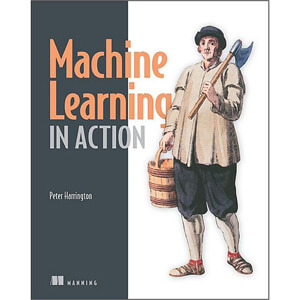Machine Learning in Action
Machine Learning in Action is unique book that blends the foundational theories of machine learning with the practical realities of building tools for everyday data analysis. You’ll use the flexible Python programming language to build programs that implement algorithms for data classification, forecasting, recommendations, and higher-level features like summarization and simplification.
A machine is said to learn when its performance improves with experience. Learning requires algorithms and programs that capture data and ferret out the interesting or useful patterns. Once the specialized domain of analysts and mathematicians, machine learning is becoming a skill needed by many.
Machine Learning in Action is a clearly written tutorial for developers. It avoids academic language and takes you straight to the techniques you’ll use in your day-to-day work. Many (Python) examples present the core algorithms of statistical data processing, data analysis, and data visualization in code you can reuse. You’ll understand the concepts and how they fit in with tactical tasks like classification, forecasting, recommendations, and higher-level features like summarization and simplification.
Readers need no prior experience with machine learning or statistical processing. Familiarity with Python is helpful.
What’s inside
A no-nonsense introduction
Examples showing common ML tasks
Everyday data analysis
Implementing classic algorithms like Apriori and Adaboos
Table of Contents
Part I: Classification
Chapter 1. Machine learning basics
Chapter 2. Classifying with k-Nearest Neighbors
Chapter 3. Splitting datasets one feature at a time: decision trees
Chapter 4. Classifying with probability theory: na?ve Bayes
Chapter 5. Logistic regression
Chapter 6. Support vector machines
Chapter 7. Improving classification with the AdaBoost meta-algorithm
Part II: Forecasting numeric values with regression
Chapter 8. Predicting numeric values: regression
Chapter 9. Tree-based regression
Part III: Unsupervised learning
Chapter 10. Grouping unlabeled items using k-means clustering
Chapter 11. Association analysis with the Apriori algorithm
Chapter 12. Efficiently finding frequent itemsets with FP-growth
Part IV: Additional tools
Chapter 13. Using principal component analysis to simplify data
Chapter 14. Simplifying data with the singular value decomposition
Chapter 15. Big data and MapReduce
Appendix A. Getting started with Python
Appendix B. Linear algebra
Appendix C. Probability refresher
Appendix D. Resources
Book Details
Paperback: 384 pages
Publisher: Manning Publications (March 2012)
Language: English
ISBN-10: 1617290181
ISBN-13: 978-1617290183
File Size: 9.1 MiB





超好看!O(∩_∩)O
超好看!O(∩_∩)O